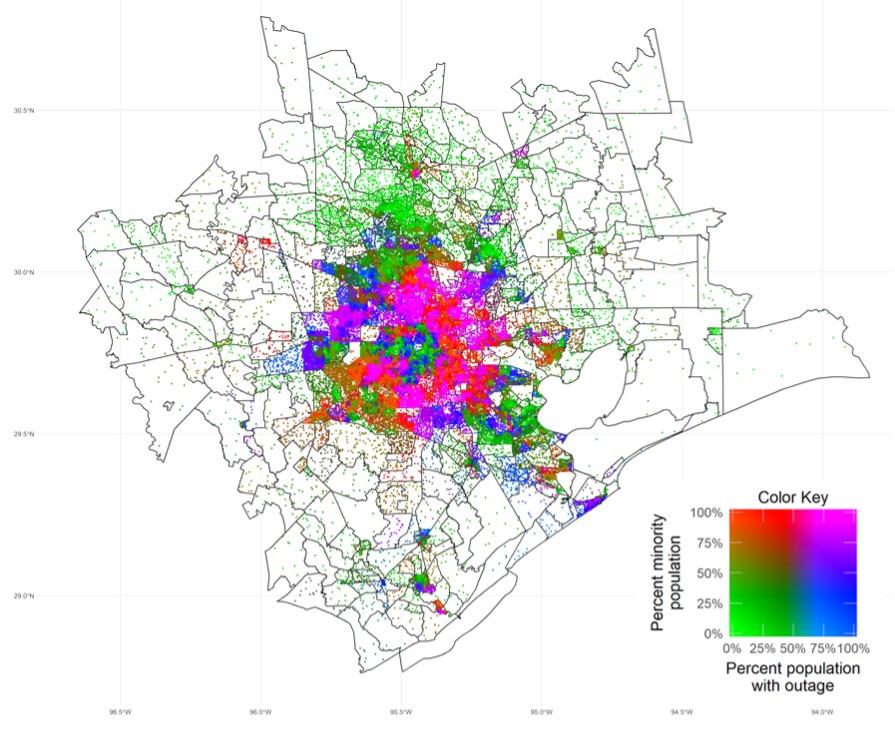Frozen out: minorities suffered four times more power outages in Texas blackouts
Satellite imagery analysis reveals the relationship between racial status and the power outages that endangered 4.5 million Texans
AMHERST, Mass. – Areas with a high share of minority population were four times more likely to have suffered a power outage during the recent Texas blackout compared to predominantly white areas, reveals a new analysis published by the Electricity Growth and Use in Developing Economies (e-GUIDE) Initiative. e-GUIDE is led by Jay Taneja, assistant professor, electrical and computer engineering at UMass Amherst.
The analysis was conducted after the events of February when a severe winter storm knocked many parts of Texas’ power grid offline for several days, leaving over 4.5 million people in the cold and dark.

The Initiative, a grantee of The Rockefeller Foundation, used satellite data of night-time lights to track changes in illumination before, during, and after the storm to indicate where blackouts had occurred. The data was then mapped to census block groups (a unit of area used as part of the U.S. census) and correlated to U.S. census demographic data throughout Texas. The highly detailed analysis reveals a striking correlation between racial status where blocks with a higher proportion of minorities were more likely to experience a power outage:
- Predominantly white areas had an 11% chance of suffering an outage compared to a 47% chance in high minority share areas.
- Income status of areas does not correlate strongly with experiencing increased or decreased blackouts.
- Presence of critical facilities – such as hospitals, police and fire stations, and water and wastewater treatment facilities – make blackouts less likely, but only by a few percentage points
e-GUIDE is a collaboration between UMass Amherst, Columbia University, Carnegie Mellon University, the Rochester Institute of Technology, and Colorado School of Mines to develop tools and transform the approaches used for the planning and operation of electricity infrastructure. The Initiative partners with electricity service companies in low- and middle-income countries, with a particular focus on sub-Saharan Africa, where more than half of the population lacks access to electricity. This work was completed in collaboration with Juan Pablo Carvallo, Principal Scientific Engineering Associate at the Lawrence Berkeley National Laboratory.
Taneja said: “Though the analysis does not tell us why differences in blackouts arise, the end result, that already-vulnerable populations endure more widespread blackouts, is tragic and unacceptable.
“While innovative datasets using satellite imagery can highlight this inequity, a failure of this magnitude is a reminder that investment in infrastructure reflects investment in communities and people. Regulators and policymakers should strive to track blackout events at the most granular level possible to identify systemic biases and develop sound policy to eliminate them and limit impacts on vulnerable communities.”
Ashvin Dayal, Senior Vice President of Power & Climate at The Rockefeller Foundation, said: Access to reliable electricity is an essential component for modernity and economic prosperity and the Texas outage illuminated the severity of living without power. Yet while Texas was able to rebound from disaster, there are nearly one billion people around the world that continue to live without power as part of their everyday lives.
“Investing in energy infrastructure, particularly distributed renewable energy, is the most impactful way to enhance prosperity of poorer communities and protect them from future hardship. We must come together to address these systemic inequalities and provide affordable access to reliable and sustainable electricity for everyone.”
Further information on the methodology can be found here:
https://www.rockefellerfoundation.org/blog/frozen-out-in-texas-blackouts-and-inequity
About e-GUIDE
The Electricity Growth and Use in Developing Economies (e-GUIDE) Initiative seeks to transform the approaches used for planning and operations of electricity infrastructure in developing regions. We are constructing measurement and data analytics techniques that are scalable, transnational, and verified using real data on electricity consumption and infrastructure. We partner with electricity service companies to develop our techniques, deploy them at scale, and build capacity for data and analytics in the electricity sector. The Initiative is funded through $5.8 million in grants from The Rockefeller Foundation. Find out more: https://eguide.io/
About The Rockefeller Foundation
The Rockefeller Foundation advances new frontiers of science, data, and innovation to solve global challenges related to health, food, power, and economic mobility. As a science-driven philanthropy focused on building collaborative relationships with partners and grantees, The Rockefeller Foundation seeks to inspire and foster large-scale human impact that promotes the well-being of humanity throughout the world by identifying and accelerating breakthrough solutions, ideas, and conversations. For more information, sign up for our newsletter at rockefellerfoundation.org and follow us on Twitter @RockefellerFdn.